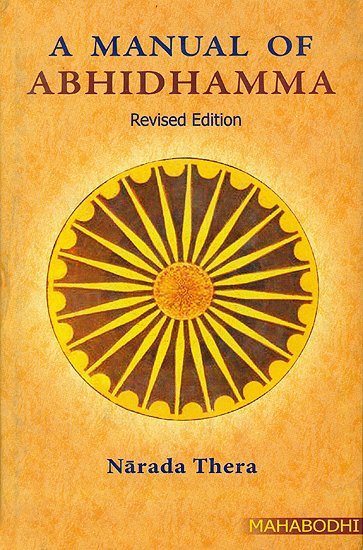A Manual of Abhidhamma
by Nārada Thera | 80,494 words | ISBN-13: 9789380336510
In the Abhidhammattha Sangaha there is a brief exposition of the Law of Dependent Origination, followed by a descriptive account of the Causal Relations that finds no parallel in any other philosophy. Edited in the original Pali Text with English Translation and Explanatory Notes by Narada Maha Thera....
§ 2.
Tattha vutt' abhidhammatthā - catudhā paramatthato
Cittam cetasikam rūpam - Nibbānam' iti sabbathā.
§ 2.
In an ultimate sense the categories of Abhidhamma, mentioned therein, are fourfold in all:-
- consciousness,
- mental states,
- matter,
- and Nibbāna.
Notes:
4. Realities - There are two realities - apparent and ultimate. Apparent reality is ordinary conventional truth (sammuti-sacca). Ultimate reality is abstract truth (paramattha-sacca).
For instance, the smooth surface of the table we see is apparent reality. In an ultimate sense the apparent surface consists of forces and qualities or in other words, vibrations.
For ordinary purposes a scientist would use the term water, but in the laboratory he would say H2O. In the same way the Buddha in the Sutta Pitaka resorts to conventional usage such as man, woman, being, self, etc., but in the Abhidhamma Pitaka He adopts a different mode of expression. Here He employs the analytical method and uses abstract terms such as aggregates (khandha), elements (dhātu), bases (āyatana), etc.
The word paramattha is of great significance in Abhidhamma. It is a compound formed of parama and attha. Parama is explained as immutable (aviparīta), abstract (nibbattita); attha means thing. Paramattha, therefore, means immutable or abstract thing. Abstract reality may be suggested as the closest equivalent. Although the term immutable is used here it should not be understood that all paramattha are eternal or permanent.
A brass vessel, for example, is not paramattha. It changes every moment and may be transmuted into a vase. Both these objects could be analyzed and reduced into fundamental material forces and qualities, which, in Abhidhamma, are termed rūpa paramattha. They are also subject to change, yet the distinctive characteristics of these rūpas are identically the same whether they are found in a vessel or a vase. They preserve their identity in whatever combination they are found - hence the commentarial interpretation of parama as immutable or real. Attha exactly corresponds to the English multi-significant term "thing". It is not used in the sense of "meaning" here.
There are four such paramattha or abstract realities. These four embrace everything that is mundane or supra mundane.
The so-called being is mundane. Nibbāna is supra mundane. The former is composed of nāma and rūpa. According to Abhidhamma rūpa connotes both fundamental units of matter and material changes as well. As such Abhidhamma enumerates 28 species of matter. These will be dealt with in a subsequent chapter. Nāma, denotes both consciousness and mental states. The second chapter of this book deals with such mental states (cetasikas) which are 52 in number. One of these is vedanā (feeling). Another is saññā (perception). The remaining 50 are collectively called sankhāra (mental states). The receptacle of these mental properties is viññāna (consciousness), which is the subject-matter of this present chapter.
According to the above analysis the so-called being is composed of five Groups or Aggregates (pañcakkhandha):-
- rūpa (matter),
- vedanā (feeling),
- saññā (perception),
- sankhāra (mental states)
- and viññāna (consciousness).
Consciousness, mental states (with the exception of 8 types of supra mundane consciousness and their adjuncts), and matter are Mundane (lokiya), and Nibbāna is Supra mundane (lokuttara). The Supra mundane Nibbāna is the only absolutely reality, which is the summum bonum of Buddhism. The other three are called realities in that they are things that exist (vijjamāna dhammā). Besides, they are irreducible, immutable, and abstract things. They deal with what is within us and around us.
The first paramattha or reality is citta. It is derived from the root citi, to think. According to the commentary citta is that which is aware of (cinteti = vijānāti) an object. It is not that which thinks of an object as the term implies. From an Abhidhamma standpoint citta may better be defined as the awareness of an object, since there is no agent like a soul.
Citta, ceta, cittuppāda, nāma, mana, viññāna are all used as synonymous terms in Abhidhamma. Hence from the Abhidhamma standpoint no distinction is made between mind and consciousness. When the so-called being is divided into its two constituent parts, nāma (mind) is used. When it is divided into five aggregates (pañcakkhandha), viññāna is used. The term citta is invariably employed while referring to different classes of consciousness. In isolated cases, in the ordinary sense of mind, both terms citta and mana are frequently used.
The other three paramatthas will be dealt with in their due places.
